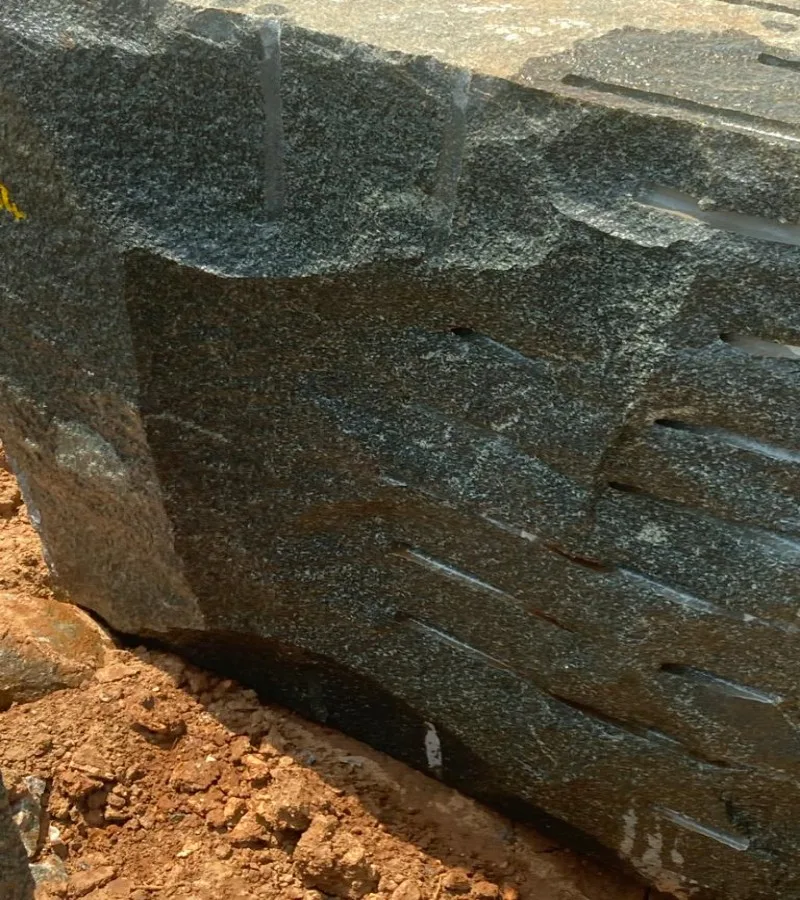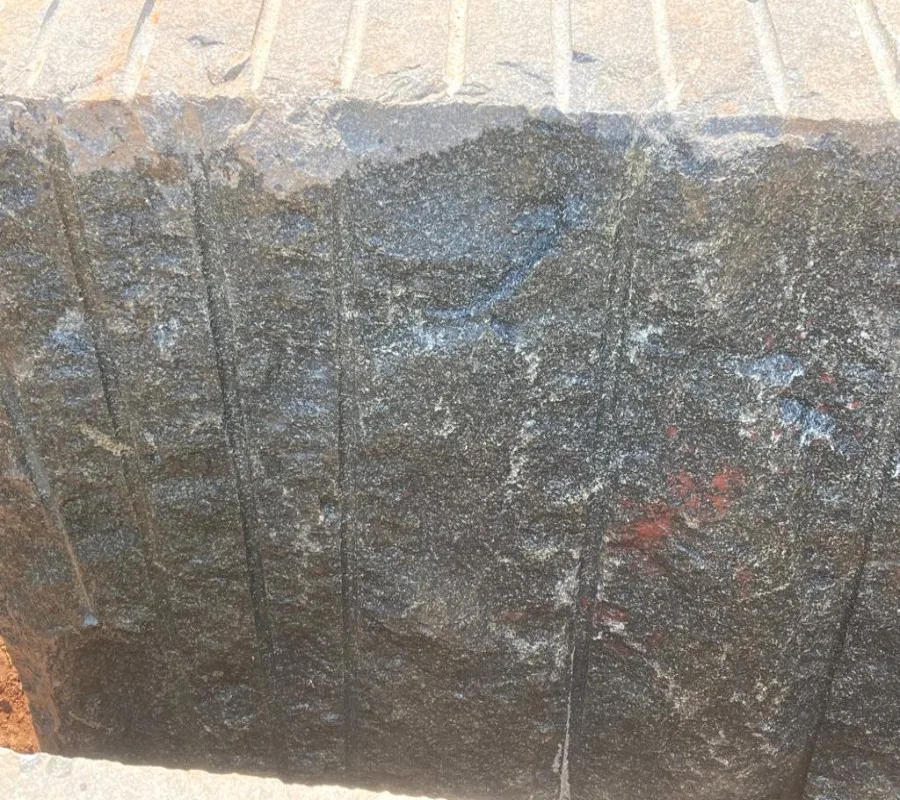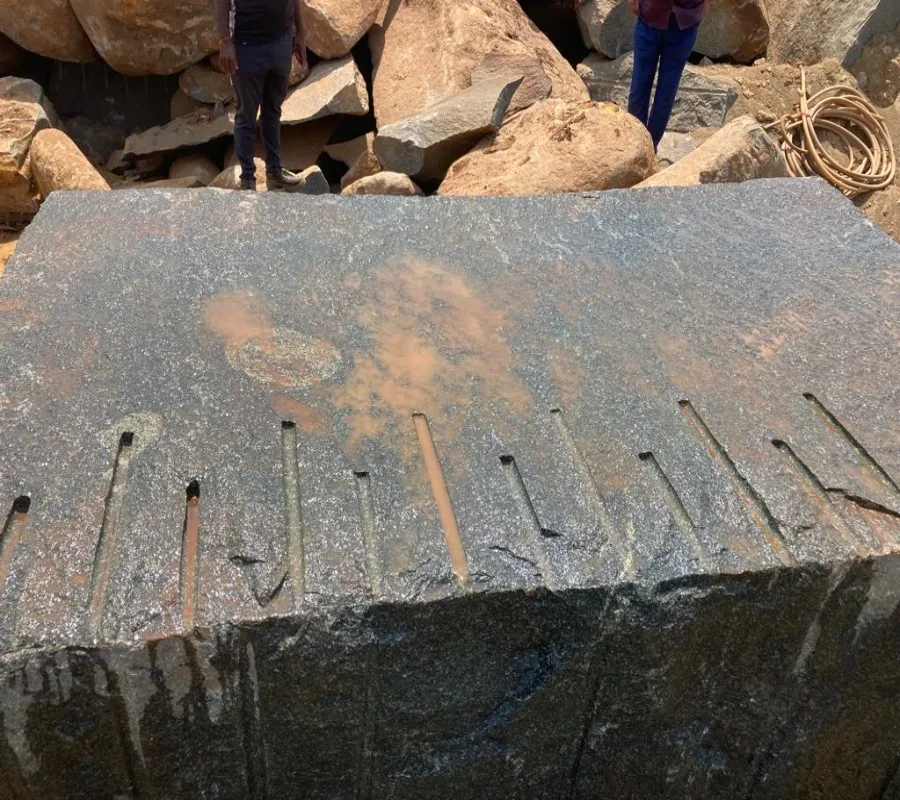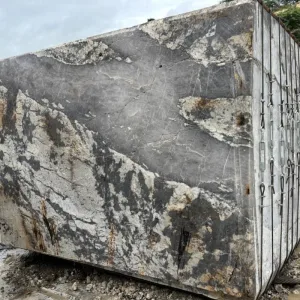Hassan Green Granite Blocks represent unprocessed raw material extracted from quarries located in the Dumgere and Sigeguda/Sigegudi regions of Hassan District, Karnataka, India. This district sits in the Western Ghats mountain range approximately 275 kilometers from Bangalore, positioning it within South India’s prolific granite belt. The region hosts numerous quarries yielding high-quality green granite blocks that have earned international recognition for distinctive coloration and reliable performance characteristics.
Geologically, Hassan Green classifies as syenite—a coarse-grained intrusive igneous rock similar to granite but with different mineral composition, formed during the Precambrian period over 2.5 billion years ago. While commercially marketed as “granite” internationally due to comparable physical properties and market positioning, European Standard applications require proper designation as syenite in technical documentation for regulatory compliance. This classification reflects geological accuracy rather than indicating any quality or performance difference from true granites.
The material’s defining visual characteristic is its rich dark green to dark grey-green coloration with lighter flecks creating a star-like or speckled pattern. These lighter inclusions—comprising green, grey, white, and black minerals—distribute evenly throughout the medium-grained texture, producing consistent appearance without dramatic veining or large-scale pattern variations. This color uniformity makes Hassan Green particularly valued for large installations where visual consistency matters more than exotic figuring.
Rough blocks serve as fundamental raw material for fabricators and processors who transform them into finished products. The blocks undergo gang-saw cutting into slabs of specified thicknesses, then surface finishing (polishing, honing, flaming, etc.), and final sizing for specific applications. Hassan Green’s medium grain structure and deep green coloration make it especially popular for monument and headstone fabrication—the somber yet elegant appearance suits memorial applications while the consistent color ensures visual harmony across cemetery installations.
Beyond monuments, the material processes into commercial flooring tiles for shopping malls, hospitals, airports, and high-traffic public spaces. The scratch-resistant, heat-resistant nature combined with dark coloration that masks surface wear makes it ideal for demanding commercial environments. Additional applications include residential and commercial kitchen countertops, bathroom vanities, building interior/exterior cladding, stair treads and risers, landscape paving, retaining walls, water features, elevator panels, and custom furniture where long-lasting natural stone provides value.
Performance and Quality
Hassan Green demonstrates performance characteristics typical of syenite and premium South Indian granites. The medium-grained structure creates tight interlocking crystals providing excellent compressive strength suitable for load-bearing applications and high-traffic flooring. The material is “exceptionally hard, robust, and weather resistant” according to supplier documentation, making it appropriate for both interior and exterior installations across diverse climate conditions.
Durability represents a key selling point—the stone resists scratches better than softer natural stones and many synthetic alternatives. Heat resistance allows safe use around fireplaces, kitchen cooktops, and outdoor grilling areas without damage from normal temperature exposures. The dense composition provides natural stain resistance, though periodic sealing enhances protection particularly for kitchen countertop applications where food preparation occurs.
Weather resistance suits Hassan Green for outdoor applications including landscaping features (walkways, garden paths, retaining walls, patios, steps), water features, and building exteriors. The material withstands freeze-thaw cycling, UV exposure, precipitation, and temperature fluctuations without significant deterioration—critical for northern climate installations and high-altitude applications where seasonal extremes occur.
The uniform green color with minimal natural variation provides commercial advantage for projects requiring visual consistency. Unlike heavily figured granites with dramatic veining where each slab differs substantially, Hassan Green maintains consistent appearance enabling large installations without pattern-matching concerns. This uniformity proves particularly valuable for commercial flooring covering expansive areas, monument fabrication requiring matched headstones, and architectural cladding projects where visual continuity matters.
Quality assessment focuses on color intensity (darker green commands premiums), grain uniformity, absence of significant natural fissures, and block dimensions. Larger blocks yield more usable slab material, reducing waste and processing costs per finished unit. Reputable quarries maintain quality control ensuring blocks meet dimensional specifications and contain minimal defects that would compromise processing efficiency or final product appearance.
Materials and Construction
Rough blocks arrive directly from quarries displaying natural rough-hewn surfaces from extraction. Modern quarrying in the Hassan region employs wire saws, controlled drilling, and wedge-splitting techniques maximizing block size while minimizing unnecessary fracturing. The syenite’s medium-grain structure facilitates clean separation along natural crystal boundaries, producing blocks suitable for gang-saw processing without excessive internal stress that might cause breakage during cutting.
Block dimensions vary based on geological conditions at specific quarry faces and extraction methods employed. Gangsaw-sized blocks (280-330cm length) suit large slab production for countertops and large-format flooring. Cutter-sized blocks (160-300cm length) serve tile production and smaller cut-to-size applications. Buyers specify minimum dimensional requirements based on intended downstream processing—fabricators with gang-saw capabilities prefer larger blocks, while tile-focused processors accommodate smaller dimensions.
The consistent medium-grain texture throughout Hassan Green facilitates processing efficiency. Unlike stones with varying grain sizes or hardness zones causing differential wear on cutting blades, Hassan Green’s uniformity enables predictable processing speeds, consistent blade life, and reliable quality outcomes. This processing efficiency contributes to favorable pricing despite the material’s premium appearance and performance characteristics.
Hassan Green’s deep green coloration results from specific mineral compositions formed during the syenite’s original cooling and crystallization. The star-like lighter flecks represent distinct mineral phases distributed throughout the primary dark green matrix. These create subtle textural interest without compromising structural integrity—the interlocking crystalline structure provides strength regardless of the color variations visible at the surface.
Processing and Downstream Applications
Fabricators receiving rough blocks process them through multiple transformation stages. Gang-saw cutting employs diamond-blade wire saws transforming blocks into slabs of specified thickness—typically 20mm (2cm) or 30mm (3cm) for countertops, with custom thicknesses from 2cm to 10cm available for specialized applications like thick countertops or architectural elements. The resulting slabs measure 280cm × 180cm and larger for jumbo gangsaw sizes, enabling seamless countertop installations and reducing visible seams in large projects.
Surface finishing follows slab cutting. Polishing creates reflective gloss surfaces highlighting the stone’s deep green color and creating elegant aesthetic suitable for luxury applications. Honing produces matte finish offering sophisticated understated appearance. Flaming creates textured surface with excellent slip resistance—the flame-finished Hassan Green proves especially popular for commercial flooring where pedestrian safety matters and the dark green coloration provides forgiving appearance that doesn’t show wear patterns prominently.
Leathered finish creates subtle texture and soft sheen combining aesthetic appeal with practical slip resistance. This finish has gained popularity for residential countertops where homeowners desire natural stone elegance with enhanced tactile experience and reduced fingerprint visibility compared to high-gloss polished surfaces.
Tile production utilizes smaller blocks or slab off-cuts, cutting calibrated pieces in standard sizes (typically 30cm×30cm, 40cm×40cm, 60cm×60cm) with consistent 10-20mm thickness. Hassan Green tiles serve residential and commercial flooring, wall cladding, bathroom installations, and mosaic applications where the uniform green color creates cohesive designs without extensive pattern coordination requirements.
| Color | Rich Green with Dark and Light Veins |
| Origin | South India |
| Texture | Compact, high-density, fine-grain structure |
| Size | 180up*60up, 200up*100up, 200up*120up, 260up*160up |
| Density | Approximately 2,700 – 2,800 kg/m³ |
Pros & Cons
Advantages
- Uniform color consistency: Dark green with evenly distributed flecks enables large installations without pattern-matching challenges; ideal for commercial flooring and monuments
- Exceptional durability: Medium-grained syenite provides scratch resistance, heat resistance, and weather resistance suitable for high-traffic commercial and harsh outdoor applications
- Budget-friendly premium stone: Competitive pricing (starting INR 90/sq ft) compared to exotic granites while offering comparable performance and elegant appearance
- Versatile finishing options: Polished, honed, flamed, leathered finishes suit diverse applications from luxury countertops to slip-resistant commercial flooring
Considerations
- Syenite vs. granite classification: Must be designated as syenite (not granite) in European Standard applications for regulatory compliance
- Processing infrastructure required: Rough blocks need gang-saw cutting facilities and finishing equipment; not suitable for retail end-users without processing capabilities
- Limited color variety: Uniform dark green lacks dramatic veining or exotic patterns; not ideal for projects requiring bold visual statements or color variation
Who Should Buy
Ideal Buyers
- Monument/memorial fabricators requiring consistent dark green granite for headstones and cemetery installations, especially those serving international markets
- Commercial flooring contractors specifying durable natural stone for shopping malls, hospitals, airports, and high-traffic public facilities
- Stone importers/distributors with gang-saw processing facilities and established markets for South Indian green granite slabs and tiles
- Middle Eastern market exporters serving UAE, Saudi Arabia, and Gulf region clients where Hassan Green maintains strong demand
- Landscape contractors requiring weather-resistant green stone for outdoor walkways, retaining walls, patio surfaces, and water features
Not Recommended For
- Retail consumers or small residential projects requiring finished slabs/tiles (purchase processed materials from local distributors instead)
- Buyers without gang-saw cutting and finishing equipment or established fabricator relationships for block processing
- Projects requiring dramatic veining, exotic patterns, or bold color variations (consider heavily figured granite varieties)
- Small-volume buyers unable to purchase minimum FCL containers (20-foot/28,000 kg) for economical direct import
- Buyers in European markets unable to accommodate syenite classification in building permits, technical specifications, and compliance documentation
FAQs
Q1: What is the difference between syenite and granite, and why does Hassan Green’s classification matter?
Syenite is a coarse-grained intrusive igneous rock similar to granite but with higher alkali feldspar content and less quartz. Hassan Green performs comparably to granite but must be properly designated as syenite in European Standard (EN) applications for building permit and regulatory compliance. This classification doesn’t indicate inferior quality—it reflects geological accuracy. The distinction matters for EU projects requiring EN standards adherence.
Q2: Why is Hassan Green particularly popular in Middle Eastern markets like UAE and Saudi Arabia?
Hassan Green maintains strong demand in Middle East due to its dark green color suiting regional design preferences, proven durability in extreme desert climate conditions, and competitive pricing. The stone’s medium grain structure and syenite composition provide favorable thermal stability during extreme daily temperature swings common in Gulf regions, reducing long-term micro-cracking risks in outdoor installations compared to some quartz-rich granites.
Q3: What is the recommended minimum order quantity for Hassan Green blocks?
While there is “no strict minimum order,” suppliers recommend Full Container Load (FCL) of 20-foot container (28,000 kg / approximately 10-14 cubic meters) for optimal shipping rates and economics. Smaller quantities may be available through consolidators at 30-50% premium pricing, or buyers can partner for shared container shipments. First-time buyers may negotiate trial containers at reduced rates.
Q4: How many cubic meters of Hassan Green blocks fit in a standard shipping container?
A 20-foot container holds approximately 28,000 kg, which translates to roughly 10-14 cubic meters of Hassan Green rough blocks depending on individual block dimensions and packing efficiency. Suppliers provide specific loading plans showing exact blocks allocated to each container. Larger 40-foot containers can accommodate proportionally more material.
Q5: What are typical gangsaw and cutter block dimensions for Hassan Green?
Gangsaw blocks (suitable for large slab production) typically measure 280-330cm length × 160-220cm width × 100-150cm height. Cutter blocks (for tile and smaller applications) measure 160-300cm length × 60-100cm width × 60-100cm height. Actual dimensions vary based on quarry geology and extraction methods. Buyers specify minimum size requirements based on intended processing.
Q6: Can Hassan Green be used for outdoor landscaping in freezing climates?
Yes. Hassan Green is described as exceptionally weather-resistant and suitable for landscaping features including walkways, garden paths, retaining walls, patios, and steps. The dense syenite structure withstands freeze-thaw cycling, UV exposure, and temperature fluctuations. The material’s proven performance in diverse international markets confirms suitability for outdoor applications in cold climates when properly installed.








